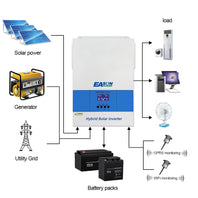The DIY Guide to Installing a Hybrid Solar Inverter in Your Home
Corps
Are you considering harnessing the power of the sun to generate electricity for your home? Installing a hybrid solar inverter can be a great way to achieve energy independence and reduce your carbon footprint. In this guide, we will walk you through the process of installing a hybrid solar inverter in your home, allowing you to take full advantage of solar power while still being connected to the grid.

Understanding the Basics
Before diving into the installation process, it's important to have a good understanding of what a hybrid solar inverter is and how it works. A hybrid solar inverter is a device that manages the energy coming from both your solar panels and the grid. It allows you to use solar power during the day and switch to grid power at night or when the sun isn't shining. This seamless transition ensures that you always have a reliable source of electricity, regardless of the weather conditions.
Assessing Your Energy Needs
Prior to installing a hybrid solar inverter, it's crucial to assess your energy needs. Consider the appliances and devices that will be powered by the solar inverter, as well as your average daily energy consumption. This information will help you determine the size and capacity of the hybrid solar inverter that is best suited for your home. Keep in mind that a professional assessment may be necessary to ensure that the system meets your specific requirements.
Choosing the Right Location
Once you have a clear understanding of your energy needs, it's time to choose the right location for installing the hybrid solar inverter. Ideally, the inverter should be placed in a well-ventilated area that is easily accessible for maintenance. It should also be installed close to your main electrical panel to minimize wiring and installation costs. Additionally, consider factors such as shading, temperature, and proximity to the solar panels when selecting the installation location.
Installation Process
Now that you have assessed your energy needs and chosen the installation location, it's time to proceed with the installation process. Begin by carefully following the manufacturer's instructions for mounting the hybrid solar inverter. Ensure that all electrical connections are made according to local building codes and regulations. It's important to emphasize that safety should be a top priority during the installation process, and if you are not confident in your abilities, it's best to seek professional assistance.
Throughout the installation, it's essential to test the system at each stage to ensure that everything is functioning as intended. Once the hybrid solar inverter is successfully installed, you can start enjoying the benefits of solar power while still being connected to the grid.
By following this DIY guide to installing a hybrid solar inverter in your home, you can take a significant step towards reducing your reliance on traditional energy sources and embracing a more sustainable way of living.










commentaires